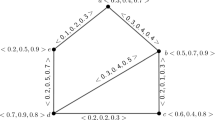Abstract
Recently, m-polar fuzzy graph (mPF graph) becomes a growing research topic as the generalization of fuzzy graph. In this paper, at first mPF path, mPF cycle in an mPF graph are defined. The strength of connectedness of mPF path is introduced. Next, strongest and strong mPF path, mPF bridges, mPF cut nodes, mPF tree and mPF forests in an mPF graph are considered. Also, it is proved that an arc of mPF tree is strong mPF arc if and only if it is an mPF bridge. Finally, mPF end nodes in an mPF graph is defined and investigated some properties of it. An application of strongest path problem in 3-polar fuzzy graph is also given at the end.








Similar content being viewed by others
References
Zhang WR (1994) Bipolar fuzzy sets and relations: a computational framework for cognitive modeling and multiagent decision analysis. In: Proceedings of IEEE conference, pp 305–309
Zhang WR (1998) Bipolar fuzzy sets. In: Proceedings of IEEE conference, pp 835–840
Chen J, Li S, Ma S, Wang X (2014) \(m\)-polar fuzzy sets: an extension of bipolar fuzzy sets. Sci World J, Article Id 416530. https://doi.org/10.1155/2014/416530
Kauffman A (1973) Introduction a la theorie des sous-emsembles flous, vol 1. Masson et Cie, Paris, p 503
Zadeh LA (1965) Fuzzy sets. Inf Control 8(3):338–353
Zadeh LA (1971) Similarity relations and fuzzy ordering. Inf Sci 3(2):177–200
Zadeh LA (2008) Is there a need for fuzzy logical? Inf Sci 178(13):2751–2779
Rosenfeld A (1975) Fuzzy graphs. In: Zadeh LA, Fu KS, Shimura M (eds) Fuzzy sets and their applications. Academic Press, New York, pp 77–95
Bhutani KR (1989) On automorphism of fuzzy graphs. Pattern Recogn Lett 9(3):159–162
Samanta S, Pal M, Pal A (2014) New concepts of fuzzy planar graph. Int J Adv Res Artif Intell 3(1):52–59
Samanta S, Pal M (2015) Fuzzy planar graphs. IEEE Trans Fuzzy Syst 23(6):1936–1942
Pramanik T, Samanta S, Pal M (2016) Interval-valued fuzzy planar graphs. Int J Mach Learn Cybern 7(4):653–664
Samanta S, Pal M (2013) Fuzzy \(k\)-competition graphs and \(p\)-competitions fuzzy graphs. Fuzzy Inf Eng 5(2):191–204
Samanta S, Akram M, Pal M (2015) \(m\)-step fuzzy competition graphs. J Appl Math Comput 47(1):461–472
Talebi AA, Rashmanlou H (2014) Complement and isomorphism on bipolar fuzzy graphs. Fuzzy Inf Eng 6(4):505–522
Ghorai G, Pal M (2018) A note on “Regular bipolar fuzzy graphs”. Neural Comput Appl 21(1), (2012) 197–205. Neural Comput Appl 30(5):1569–1572
Yang HL, Li SG, Yang WH, Lu Y (2013) Notes on “bipolar fuzzy graphs”. Inf Sci 242:113–121
Rashmanlou H, Samanta S, Pal M, Borzooei RA (2015) A study on bipolar fuzzy graphs. J Intell Fuzzy Syst 28(2):571–580
Rashmanlou H, Samanta S, Pal M, Borzooei RA (2015) Bipolar fuzzy graphs with categorical properties. Int J Comput Intell Syst 8(5):808–818
Akram M (2011) Bipolar fuzzy grpahs. Inf Sci 181(24):5548–5564
Akram M (2013) Bipolar fuzzy grpahs with applications. Knowl Based Syst 39:1–8
Ghorai G, Pal M, Rashmanlou H, Borzooei RA (2017) New concepts of regularity in product \(m\)-polar fuzzy graphs. Int J Math Comput 28(4):9–20
Ghorai G, Pal M (2017) Ceratin types of product bipolar fuzzy graphs. Int J Appl Comput Math 3(2):605–619
Ghorai G, Pal M (2016) Faces and dual of \(m\)-polar fuzzy planar graphs. J Intell Fuzzy Syst 31(3):2043–2049
Ghorai G, Pal M (2016) Some isomorphic properties of \(m\)-polar fuzzy graphs with applications. SpringerPlus 5(1):1–21
Ghorai G, Pal M (2017) Planarity in vague graphs with application. Acta Math Acad Paedagog Nyregyhziensis 33(2):147–162
Ghorai G, Pal M (2016) A study on \(m\)-polar fuzzy planar graphs. Int J Comput Sci Math 7(3):283–292
Ghorai G, Pal M (2016) Regular product vague graphs and product vague line graphs. Cogent Math 3(1):1–13
Ghorai G, Pal M (2015) On some operations and density of \(m\)-polar fuzzy graphs. Pac Sci Rev A Nat Sci Eng 17(1):14–22
Ghorai G, Pal M (2016) Some properties of \(m\)-polar fuzzy graphs. Pac Sci Rev A Nat Sci Eng 18(1):38–46
Ghorai G, Pal M (2017) Novel concepts of strongly edge irregular \(m\)-polar fuzzy graphs. Int J Appl Comput Math 3(4):3321–3332
Sahoo S, Pal M (2015) Intuitionistic fuzzy competition graph. J Appl Math Comput 52(1):37–57
Sahoo S, Pal M (2017) Intuitionistic fuzzy tolerance graphs with application. J Appl Math Comput 55(1):495–511
Sahoo S, Pal M (2015) Different types of products on intuitionistic fuzzy graphs. Pac Sci Rev A Nat Sci Eng 17(3):87–96
Sahoo S, Pal M (2016) Product of intuitionistic fuzzy graphs and degree. J Intell Fuzzy Syst 32(1):1059–1067
Tong S, Sun K, Sui S (2018) Observer-based adaptive fuzzy decentralized optimal control design for strict-feedback nonlinear large-scale systems. IEEE Trans Fuzzy Syst 26(2):569–584
Sun K, Li Y, Tong S (2017) Fuzzy adaptive output feedback optimal control design for strict-feedback nonlinear systems. IEEE Trans Syst Man Cybern Syst 47(1):33–44
Sun K, Sui S, Tong S (2018) Fuzzy adaptive decentralized optimal control for strict feedback nonlinear large-scale systems. IEEE Trans Cybern 48(4):1326–1339
Acknowledgements
The authors are highly thankful to the honorable Editor in Chief, Associate Editor and the honorable reviewers for their valuable suggestions which significantly improved the quality and representation of the paper. Financial support of first author by University Grants Commission, New Delhi, India(Fl-17.112014-15/RGNF-2014-15-SC-WES-63919(SA-Ill/Website)) is thankfully acknowledged.
Author information
Authors and Affiliations
Corresponding author
Additional information
Publisher's Note
Springer Nature remains neutral with regard to jurisdictional claims in published maps and institutional affiliations.
Rights and permissions
About this article
Cite this article
Mandal, S., Sahoo, S., Ghorai, G. et al. Application of Strong Arcs in m-Polar Fuzzy Graphs. Neural Process Lett 50, 771–784 (2019). https://doi.org/10.1007/s11063-018-9934-1
Published:
Issue Date:
DOI: https://doi.org/10.1007/s11063-018-9934-1




